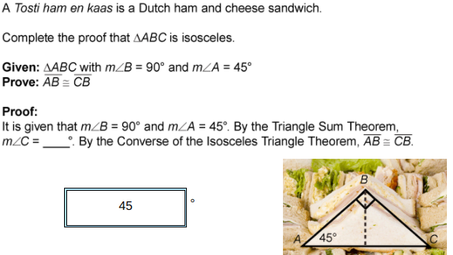What else can I help you with?
What must A measure in order for ABC to be isosceles?
Are you talking about the angle A. If you are then at what point of the triangle is the angle A.
If the median to a side of a triangle is also an altitude to that side then the triangle is isosceles How do you write this Proof?
Let the triangle be ABC and suppose the median AD is also an altitude.AD is a median, therefore BD = CDAD is an altitude, therefore angle ADB = angle ADC = 90 degreesThen, in triangles ABD and ACD,AD is common,angle ADB = angle ADCand BD = CDTherefore the two triangles are congruent (SAS).And therefore AB = AC, that is, the triangle is isosceles.
If an isosceles triangle has two equal sides that are 14 feet long and the third side is 17 feet long what are the angles?
Let the Isosceles Triangle be ∆ ABC with sides AB = AC = 14', and BC = 17' Draw a line bIsecting angle BAC. This line will be perpendicular to and bisect BC at point D. Then ∆ DBA (or ∆ DCA) is a right angled triangle with AB the hypotenuse. Angle ABD = Angle ABC is one of the two equal angles of the isosceles triangle. Cos ABD = BD/AB = 8.5/14 = 0.607143, therefore Angle ABC = 52.62° The third angle of the triangle is 180 - (2 x 52.62) = 180 - 105.24 = 74.76° The angles are therefore 52.62° , 52.62° and 74.76° .
How do you prove the isosceles triangle theorem?
The isosceles triangle theorem states: If two sides of a triangle are congruent, then the angles opposite to them are congruent Here is the proof: Draw triangle ABC with side AB congruent to side BC so the triangle is isosceles. Want to prove angle BAC is congruent to angle BCA Now draw an angle bisector of angle ABC that inersects side AC at a point P. ABP is congruent to CPB because ray BP is a bisector of angle ABC Now we know side BP is congruent to side BP. So we have side AB congruent to BC and side BP congruent to BP and the angles between them are ABP and CBP and those are congruent as well so we use SAS (side angle side) Now angle BAC and BCA are corresponding angles of congruent triangles to they are congruent and we are done! QED. Another proof: The area of a triangle is equal to 1/2*a*b*sin(C), where a and b are lengths of adjacent sides, and C is the angle between the two sides. Suppose we have a triangle ABC, where the lengths of the sides AB and AC are equal. Then the area of ABC = 1/2*AB*BC*sin(B) = 1/2*AC*CB*sin(C). Canceling, we have sin(B) = sin(C). Since the angles of a triangle sum to 180 degrees, B and C are both acute. Therefore, angle B is congruent to angle C. Altering the proof slightly gives us the converse to the above theorem, namely that if a triangle has two congruent angles, then the sides opposite to them are congruent as well.
How is an isosceles trapezoid related to an isoceles triangle?
If the sloped sides of an isosceles trapezium are extended to a vertex, you would get an isosceles triangle.If the sloped sides of an isosceles trapezium are extended to a vertex, you would get an isosceles triangle.If the sloped sides of an isosceles trapezium are extended to a vertex, you would get an isosceles triangle.If the sloped sides of an isosceles trapezium are extended to a vertex, you would get an isosceles triangle.
complete the paragraph proof?
converse of the isosceles triangle theorem
If bd is both the altitude and median of abc then abc is?
Isosceles
what- Given ABC is isosceles with?
true
If is both the altitude and median of triangle ABC then triangle ABC is?
It is isosceles.
If is both the altitude and median of triangle ABC then triangle ABC is .?
It is isosceles.
If in ABC B is equal to C what kind of triangle is ABC?
Triangle ABC would be an isosceles. An isosceles triangle is defined as having two sides of equal length. This would also mean, then, that two angles in the triangle are also the same.
The parallelogram ABCD is a rhombus what type of triangle is ABC?
isosceles triangle
If triangle ABC is an isosceles triangle hat is the measure of side AB?
12squigally2
If ABC is an isosceles triangle with base AC what is the measure of C?
30 degrees
If triangle abc is an isosceles triangle what is the measure of side ab?
12 2
if an isosceles triangle ABC is dilated by a scale factor of 3, which of the following statements is not true?
the sides of ABC are congruent to the sides of A'B'C'
which completes the paragraph proof?
converse of the isosceles triangle theorem

